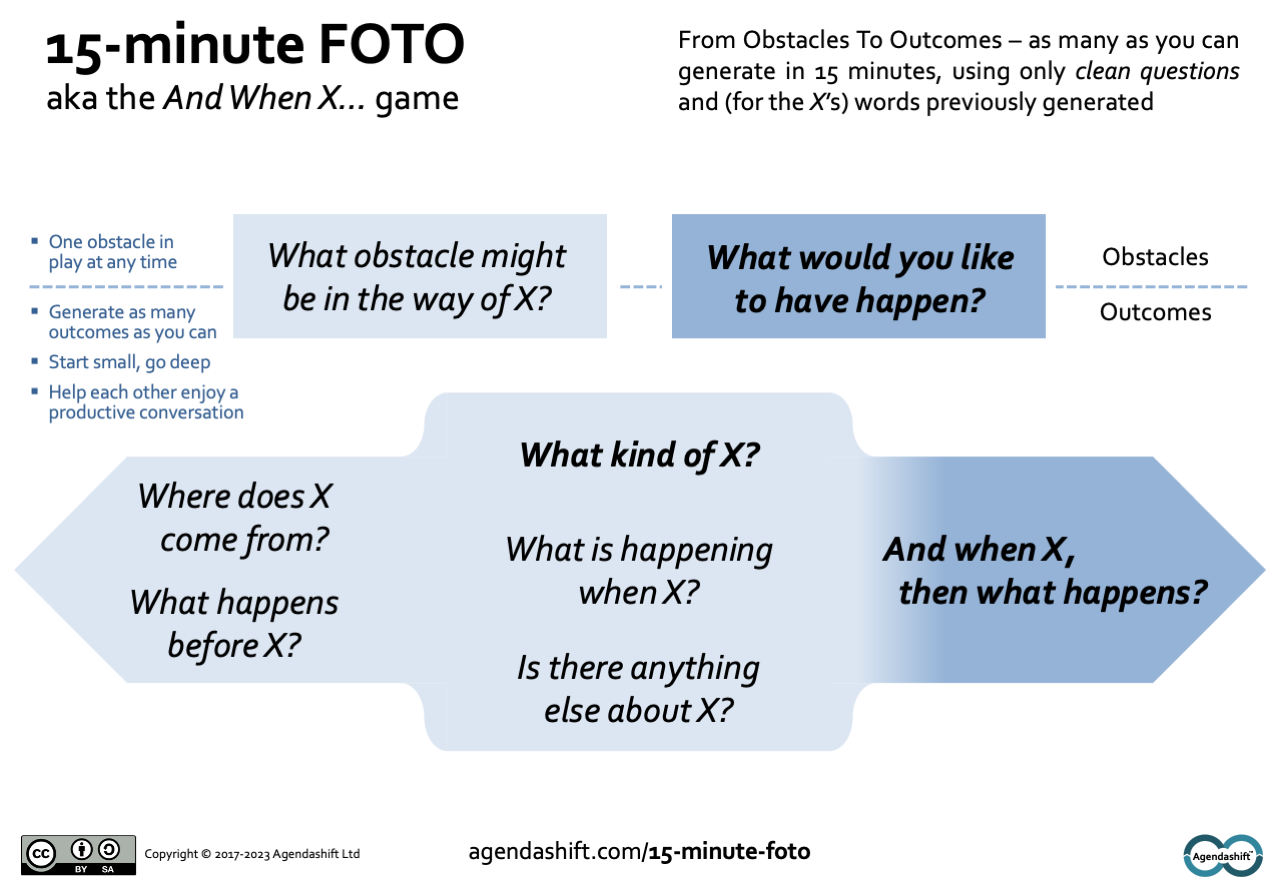I need to lead in a transforming organisation:
I want to help others to lead with outcomes:
We help leaders and engaged team members at every level to gain fluency in the language of outcomes – developing and pursuing strategies together, innovating and adapting as the organisation learns to renew and transform itself. More...
Resources: 15-minute FOTO
15-minute FOTO – aka the And when X... game¹ – is our Creative Commons-licensed and Clean Language-inspired coaching game that’s not only for coaches – everyone gets a turn! Consistently, it’s a highlight of our workshops: it’s fun and surprisingly practical, generating not just insights but a good quantity of relevant outputs. It’s the main tool by which we generate outcomes – outcomes that can then be organised strategically.
FOTO stands for “From Obstacles to Outcomes”, and the game’s objective is to generate as any outcomes as you can in the allotted time – 15 minutes for a table group working together in the Lite format, or 3-4 minutes per rotation (plus some changeover time) through the Classic format’s roles of client, coach, and host.
As well as an objective, 15-minute FOTO has rules, two of them – it is a game after all! They make it a generative process:
- You can only ask questions from the card
- For the X’s in many of the questions, you must use words previously generated (obstacles, outcomes, or fragments thereof), verbatim
There are no wrong answers, but the intent of the questioning should be to elicit outcomes in a spirit of curiosity, not to fish for solutions. Given the game’s objective, it is also not productive to spend too much time digging into obstacles; some quick clarification may be helpful however.
The 15-minute FOTO cue card
If playing in person (as opposed to online), we strongly recommend that the cue cards are printed on A5-sized card, one per person. It is difficult to hold face-to-face conversation when looking at screen! Accordingly, the facilitation deck includes some slides to be shown or hidden for online and offline use.
If you’d like access to Dropbox with all the original files for the cue cards, the facilitator’s deck, and the latest translations (versions of the cue card are available in French, German, Italian, and Swedish), just ask via the button below.
Classic and Lite formats
Instructions specific to the two formats:
- Classic format – rotating every few minutes through the roles of Client, Coach, and Host so that everyone gets a turn in every role
- Lite format – anyone can ask, anyone can answer – but don’t get stuck too long in one role or on one obstacle
Role responsibilities:
- Client: Chooses obstacles, responds to the coach’s questions with short, bullet point answers
- Coach: Guides the conversation using only the clean questions from the card and the client’s own words
- Host: Helps others enjoy a productive conversation, ensuring that “anything that sounds like an outcome” gets captured
Understanding both formats can help participants to get up and running quickly (which is important). It doesn’t hurt therefore to show slides specific to the format you aren’t using, but you can skip or hide them if you prefer. There is nothing to prevent groups self-organising the Lite format into the Classic format, but the former may be seen as less intense. If you have the opportunity to play the game twice, use the more relaxed Lite format first and the Classic format second.
Cheat mode
As explained in the blog post 15-minute FOTO’s cheat mode (October 2023), 15-minute FOTO allows the use of the following question (or variants thereof):
- Why is that important?
This question is not Clean, but can be “cleanish”, ie in the context in which it is carefully used, it does not make unwarranted assumptions. This is reasonable for (say) a prioritised obstacle.
15-minute FOTO at the Agendashift Academy
Within the [Agendashift Academy][academy]'s core curriculum Leading with Outcomes, 15-minute FOTO is introduced in the module Inside-out Strategy (I): On the same page with purpose, further developed in Inside-out Strategy (II): Fit for maximum impact, and used in the Adaptive Organisation and Outside-in Strategy modules. Before those, Leading with Outcomes: Foundation prepares the ground with some introductory exercises.
All of the above are available in self-paced and instructor-led formats. With the exception of the Foundation module, they all have close correspondences with our facilitated workshops:
- The Leading with Outcomes Discovery Workshop
- The Leading with Outcomes Assessment Debrief Workshop
- Adaptive Organisation Workshop
- Outside-in Strategy Review workshop
- Leading in a Transforming Organisation
Except for the Adaptive Organisation Workshop, all of those use 15-minute FOTO by default; a shorter, Foundation-style exercise may be used in its place.
Academy subscribers and supporters have access (via the premium resources page) to an introductory video and a slightly expanded facilitation deck formatted in the Adademy's house style.
Video
To see this game used in conjunction with the Agendashift True North, watch Exercises in Lean-Agile Transformation with Mike Burrows (youtube.com, 2017):
Read more: chapters 1 & 2 of Agendashift: Outcome-oriented change and continuous transformation (2nd edition 2021). See also our cheat sheet.
Facilitation tips
- Watch the video, familiarise yourself with the deck (even if you don’t intend to use it) and study the generative pattern Ideal, Obstacles, Outcomes (IdOO) as introduced in Leading with Outcomes: Foundation
- Consider studying the two-part Inside-out Strategy module:
- Table groups of 3-5 people – smaller is often better, but 2 is too few
- When introducing the game, take the time to demonstrate how the Clean questions work:
- Taking the coach role, practice with a sample obstacle or two (see the “Try them“ opportunity in the deck)
- Be ready with some examples of your own – see for example the blog post My favourite Clean Language question
- Emphasise the three questions in bold – it’s possible to play the game with only these
- Set the expectation that they should be able to generate a good number of outcomes (a dozen or more) in the limited time available. Warn that if ever a minute passes without an obstacle being captured, something is wrong – either:
- Digging into obstacles, forgetting to ask “What would you like to have happen?”
- Being too strict in what they accept, missing intermediate outcomes in the search for the ultimate outcome perhaps
- Discussing the process instead of trying it
- Give the reassurance that if they find the conversation repeating itself, congratulations – they have found a virtuous circle! Retrace to an earlier part of the conversation and take it in a different direction
- If you’re playing the Classic format:
- Make sure i) that each table group knows who is in each role, and ii) that the first client has chosen an obstacle
- Every few minutes the roles rotate: “New client, new obstacle! And rotate the other roles”
- Allow some time for changeover but maintain some pace and energy
- If you decide to extend the exercise after the time is up, that’s ok
- You can get your list of obstacles (a required input to the game) from a variety of sources, for example:
- Your retrospectives, and more specifically by reflection on customer dissatisfactions and team frustrations (see chapter 3 of the book)
- The results of an exercise to reflect on a generative image, of which our True North statement is a good example
- After prioritising the results of an assessment (chapter 2)
- See also Obstacles Fast and Slow (formerly Good Obstacle, Bad Obstacle)
- Don’t skimp on printing; reading the questions off a screen doesn’t work nearly so well, and it’s good to give everyone something they can take away
- Debrief afterwards:
- The experience, by role, always starting with when it was working well for the Client role
- The results, organised perhaps into a Plan on a Page, a template for which is included in the 15-minute FOTO materials
Finally, do encourage participants interested in Clean Language to check out our recommended reading page as highlighed at the end of the deck.
Questions?
Depending on the nature of your question, try one of these channels in the Agendashift Slack:
- #cleanlanguage
- #workshops
- #coaching
- #agendashift-book
Alternatively, get in touch via our contact page.
Copyright © 2015-2024 Agendashift Ltd (formerly Positive Incline Ltd). All rights reserved. The page 15-minute FOTO by Mike Burrows of Agendashift Ltd is licensed under the Creative Commons Attribution-ShareAlike 4.0 International License. To view a copy of this license, visit https://creativecommons.org/licenses/by-sa/4.0/.
Source text maintained at github.com/asplake/agendashift-open/tree/master/resources/15-minute-foto.md (github.com)
For materials (or simply to join the Agendashift mailing list), just ask:
I understand that I will be joining the Agendashift mailing list also
Related
-
About Agendashift
- Our mission: Wholehearted
- Agendashift Assessments and Free 14-day trial
- Events calendar – training and other events
- Subscribe
- Leading with Outcomes from the Agendashift Academy (academy.agendashift.com):
-
The books:
- Agendashift: Outcome-oriented change and continuous transformation (2nd edition 2021)
- Right to Left: The digital leader’s guide to Lean and Agile (2019, audiobook 2020)
- Agendashift as framework
- Resources
- The Agendashift blog (blog.agendashift.com)
- Agendashift communities on Slack and LinkedIn
Meet us online
- Subscribe (1-3 emails per month)
- Read our blog: blog.agendashift.com
- Join Agendashift on Slack
- Join our LinkedIn group: Agendashift
- Follow us on Twitter: @agendashift
About us
Agendashift™ is brought to you by Agendashift Ltd (formerly Positive Incline Ltd), UK-based specialists in leadership, engagement, strategy, and change. Founder Mike Burrows came to prominence in the Lean-Agile community as the originator of Kanban’s values model, out of which came his first book, Kanban from the Inside (2014). His more recent books Agendashift (2nd edition 2021) and Right to Left (2019, audiobook 2020) bring a resolutely needs-based and outcome-oriented perspective to change, transformation, and the Lean-Agile landscape as a whole, contributing meanwhile a number of popular tools, games, and other resources. He works as a consultant, facilitator, and trainer, and as a keynote speaker at events public and private around the world.
Copyright © 2015-2024 Agendashift Ltd (formerly Positive Incline Ltd). All rights reserved. Privacy, security, and usage policies


